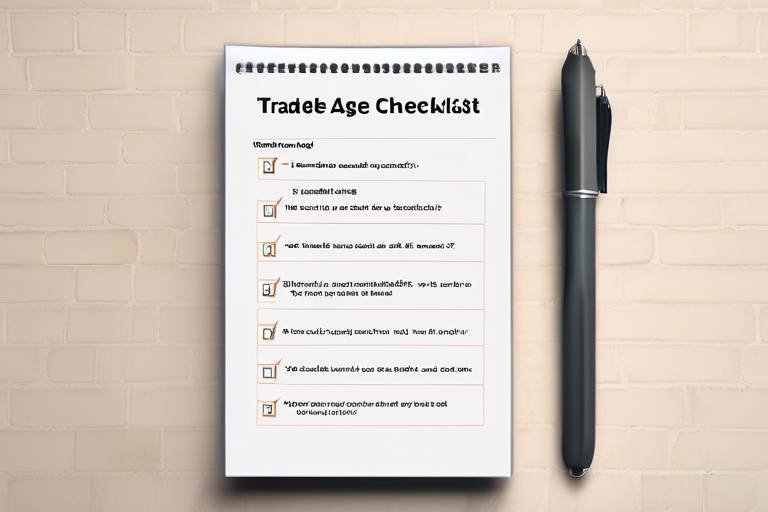How to Avoid Common Trading Mistakes
Trading can be an exhilarating journey, but it’s also fraught with pitfalls that can trip up even the most seasoned traders. The key to navigating this complex landscape is to be aware of the common mistakes that can derail your trading strategy. By understanding these pitfalls and implementing effective strategies, you can significantly enhance your trading outcomes and make more informed decisions.
One of the most critical aspects of trading is being mindful of your emotions. Many traders fall victim to fear and greed, which can cloud judgment and lead to poor decision-making. For instance, the fear of missing out (FOMO) can push traders to enter positions at the wrong time, while the lure of quick profits can lead to reckless trading behavior. To combat these emotional triggers, it's essential to develop a disciplined mindset. Techniques such as mindfulness, journaling your trades, and setting strict entry and exit criteria can help maintain emotional control, allowing you to make decisions based on logic rather than impulse.
Another common mistake is setting unrealistic goals. Many traders enter the market with lofty expectations, hoping to turn a small investment into a fortune overnight. However, this mindset often leads to frustration and disappointment. By establishing realistic trading goals, you can maintain focus and measure your progress more effectively. This approach not only helps to manage expectations but also fosters a sense of achievement as you reach smaller, attainable milestones along the way.
Trading psychology plays a pivotal role in your success. It's not just about numbers and charts; it's about understanding how your mind works under pressure. The emotional rollercoaster of trading can lead to impulsive decisions that stray from your original plan. By recognizing these psychological factors, you can develop strategies to counteract them. For example, taking regular breaks from trading can help clear your mind and reduce stress, allowing you to return with a fresh perspective.
Setting realistic goals is crucial in the trading world. Without clear objectives, it's easy to lose direction and make mistakes. Goals should be specific, measurable, achievable, relevant, and time-bound (SMART). For instance, instead of saying, "I want to make money trading," you might say, "I aim to achieve a 10% return on my investment over the next six months." This specific goal gives you a clear target to work towards and helps you stay accountable.
The SMART framework is a powerful tool for traders. Here's a breakdown of each component:
- Specific: Clearly define what you want to achieve.
- Measurable: Ensure that you can track your progress.
- Achievable: Set realistic goals that are attainable.
- Relevant: Align your goals with your overall trading strategy.
- Time-bound: Set a deadline to create urgency.
Here are a few examples of how to apply the SMART criteria in your trading:
| Goal Type | SMART Example |
|---|---|
| Profit Target | Aim for a 15% increase in my trading account over the next quarter. |
| Learning | Complete a trading course within the next two months. |
| Risk Management | Limit losses to 2% of my total capital on any single trade. |
Flexibility is vital in trading. As market conditions change, so should your goals. Regularly reviewing and adjusting your objectives ensures they remain relevant and attainable. This adaptability can be the difference between success and failure in the ever-evolving trading landscape. It’s like sailing a ship; sometimes, you need to change course to reach your destination effectively.
A well-structured trading plan is your roadmap to success. It should outline your trading strategy, risk management techniques, and performance evaluation methods. By having a clear plan, you minimize the chances of making impulsive decisions based on market noise. Your trading plan should include:
- Your trading goals
- Entry and exit strategies
- Risk management rules
- Performance evaluation criteria
Risk management is not just about protecting your capital; it’s about ensuring longevity in the trading game. Effective risk management strategies can help you navigate the ups and downs of the market with confidence. Techniques such as setting stop-loss orders, diversifying your portfolio, and regularly assessing your risk tolerance are essential for minimizing losses.
Diversification is a powerful risk management tool. By spreading your investments across different assets, you can mitigate risk and enhance potential returns. Think of it like not putting all your eggs in one basket; if one investment falters, others may thrive, balancing your overall portfolio performance.
Position sizing is another crucial aspect of risk management. It determines how much of your capital you allocate to a single trade. By carefully calculating your position size based on your risk tolerance and the specifics of the trade, you can ensure that no single trade can significantly impact your overall portfolio. This disciplined approach helps you maintain control and reduces the likelihood of devastating losses.
Q1: What is the most common mistake traders make?
A1: One of the most common mistakes is letting emotions like fear and greed dictate trading decisions.
Q2: How can I create a solid trading plan?
A2: A solid trading plan should include your trading goals, strategies, risk management rules, and performance evaluation criteria.
Q3: Why is risk management important?
A3: Risk management is essential to protect your capital and ensure you can continue trading in the long run.
Q4: How often should I adjust my trading goals?
A4: Regularly review and adjust your goals based on market conditions and personal circumstances to keep them relevant and achievable.

Understanding Trading Psychology
Trading isn't just about numbers and charts; it's a mental game, too. The psychology of trading plays a pivotal role in the decisions traders make. Think of it like riding a roller coaster—there are thrilling highs and gut-wrenching lows. When traders are caught in the grip of emotions like fear and greed, they often make choices that lead to significant losses. For instance, fear can cause a trader to panic sell during a market dip, while greed might push them to hold onto a winning position for too long, hoping for even greater profits.
To combat these emotional pitfalls, it's crucial to develop a disciplined mindset. This can be achieved through various techniques. One effective method is to establish a trading routine. By following a consistent plan, traders can reduce the influence of their emotions. For example, setting specific times to analyze the market or sticking to predetermined entry and exit points can help maintain focus and prevent impulsive decisions. Additionally, practicing mindfulness techniques, such as meditation or deep breathing, can aid in maintaining emotional balance during trading sessions.
Another essential aspect of trading psychology is recognizing the impact of loss aversion. This is the tendency for traders to feel the pain of a loss more intensely than the pleasure of a gain. It’s like having a bad breakup; the memories of the pain linger far longer than the joy of the happy moments. Understanding this can help traders approach their losses with a more rational mindset. Instead of dwelling on what went wrong, they can analyze the situation, learn from it, and move forward without letting it cloud their judgment.
Moreover, traders should also be aware of the bandwagon effect, which occurs when individuals follow the crowd, often leading to irrational decisions. It's like the classic scenario of everyone rushing to the exit during a fire drill—just because others are doing it doesn’t mean it’s the right choice. To avoid this, traders should stick to their strategies and resist the urge to jump on trending stocks or popular trading strategies without proper analysis.
In conclusion, understanding trading psychology is fundamental for anyone looking to succeed in the trading arena. By recognizing the emotional triggers that can lead to poor decisions, traders can implement strategies to maintain discipline, manage their emotions, and ultimately improve their trading outcomes. Remember, trading is as much about mental fortitude as it is about market knowledge. So, the next time you find yourself in a heated moment, take a step back, breathe, and reflect on your strategy.

Setting Realistic Goals
When it comes to trading, setting realistic goals is not just a good practice; it's a game changer. Imagine trying to climb a mountain without a clear path—it's daunting and often leads to frustration. Similarly, without well-defined goals, traders can easily find themselves lost in a sea of decisions, making impulsive choices that can derail their trading journey. So, how do you establish goals that are not only achievable but also motivating?
First and foremost, it's essential to recognize that unrealistic expectations can lead to disappointment and rash actions. For instance, a new trader might dream of doubling their investment in a month, but such aspirations often set them up for failure. Instead, focusing on smaller, incremental gains can provide a sense of accomplishment and keep motivation high. Think about it: would you rather aim for the stars and risk falling hard, or take steady steps and reach your destination safely?
To effectively set these goals, consider using the SMART Goals Framework. This method provides a structured approach to goal-setting, ensuring that your objectives are not just dreams but actionable plans. The SMART criteria stands for:
- Specific: Clearly define what you want to achieve.
- Measurable: Establish criteria to measure your progress.
- Achievable: Set realistic goals that are attainable.
- Relevant: Ensure your goals align with your overall trading strategy.
- Time-bound: Set a deadline for your goals to create urgency.
For example, rather than saying, "I want to be a better trader," a SMART goal would be, "I will study trading strategies for 30 minutes every day for the next month." This goal is specific, measurable, achievable, relevant, and time-bound. It gives you a clear direction and a timeline, making it easier to stay focused and motivated.
Another critical aspect of setting realistic goals is the flexibility to adjust them over time. Market conditions change, and so do personal circumstances. If a particular strategy isn't yielding the expected results, it’s crucial to reassess and modify your goals accordingly. This adaptability not only helps in navigating the unpredictable nature of trading but also fosters a mindset geared toward long-term success.
In conclusion, setting realistic goals is about creating a roadmap that guides your trading journey. By employing the SMART framework and remaining flexible, you can cultivate a disciplined approach that enhances your trading performance. Remember, it’s not just about the destination; it’s about the journey and learning along the way.
Q: Why is it important to set realistic trading goals?
A: Setting realistic trading goals helps maintain motivation, provides clear direction, and reduces the likelihood of making impulsive decisions that can lead to losses.
Q: How can I ensure my goals are achievable?
A: Use the SMART criteria to assess your goals. Ensure they are specific, measurable, achievable, relevant, and time-bound.
Q: What should I do if my trading goals are not being met?
A: Reevaluate your goals and strategies. Market conditions may have changed, or your approach may need adjustment. Flexibility is key!

SMART Goals Framework
When it comes to trading, having a clear direction is crucial. This is where the comes into play. The acronym SMART stands for Specific, Measurable, Achievable, Relevant, and Time-bound. Each component serves as a guideline to help traders formulate effective goals that can significantly enhance their trading performance. Think of it like a roadmap: without a clear path, you might find yourself lost in the vast world of trading.
Let’s break down each element:
- Specific: Your goals should be clear and specific. Instead of saying, “I want to make money trading,” specify how much you aim to earn and in what time frame. For example, “I want to earn $500 in the next month by trading tech stocks.”
- Measurable: It’s essential to have criteria for measuring progress. This could be tracking your daily or weekly trades and assessing whether you are on track to hit your financial target.
- Achievable: While it's great to dream big, your goals should also be realistic. Setting a goal to double your investment in a week is likely unrealistic and can lead to poor decision-making. Instead, focus on steady, incremental gains.
- Relevant: Ensure that your goals align with your overall trading strategy and personal circumstances. If you’re a part-time trader, setting a goal that requires full-time dedication may not be relevant.
- Time-bound: Every goal should have a deadline. This creates a sense of urgency and helps you stay focused. For instance, aim to achieve your specific trading target within a set time frame, such as three months.
By integrating the SMART criteria into your trading goals, you can create a structured approach that not only helps you stay focused but also allows you to measure your progress effectively. This structured methodology can transform your trading journey from a vague aspiration into a well-defined path towards success.
For example, instead of saying, “I want to improve my trading skills,” you might say, “I will read one trading book each month and apply at least one strategy from it in my trades.” This goal is specific, measurable, achievable, relevant, and time-bound, making it much more effective.
Moreover, it’s important to revisit and adjust your SMART goals periodically. Markets are dynamic, and your circumstances may change. Flexibility is key; adapting your goals in response to changing market conditions or personal situations can keep you on track and prevent frustration. Remember, trading is not just about making profits; it’s also about continual learning and adapting to the environment.

Examples of SMART Goals
When it comes to trading, having clear and actionable goals is crucial. The SMART framework—Specific, Measurable, Achievable, Relevant, and Time-bound—provides a solid foundation for traders to formulate their objectives. Let's dive into some practical examples that illustrate how you can apply this framework to enhance your trading performance.
Imagine you're a trader who wants to improve your skills over the next six months. Instead of saying, "I want to be a better trader," you could set a SMART goal like this: "I will complete three online trading courses focused on technical analysis and apply what I learn in my trades over the next six months." This goal is specific (three courses), measurable (completion of each course can be tracked), achievable (realistic within the timeframe), relevant (directly improves your trading skills), and time-bound (six months).
Another example could be related to your trading performance. Instead of vaguely stating, "I want to make more profits," you could say, "I will increase my trading account balance by 15% over the next quarter by implementing a new risk management strategy and conducting weekly performance reviews." This goal is also specific (15% increase), measurable (account balance can be tracked), achievable (considering your current performance), relevant (direct impact on your trading success), and time-bound (within the next quarter).
To further illustrate the effectiveness of SMART goals, here’s a table showcasing various examples:
| Goal Type | SMART Goal Example |
|---|---|
| Skill Development | I will attend two trading webinars each month for the next three months to improve my knowledge of market trends. |
| Performance Improvement | I will maintain a win rate of at least 60% over the next 20 trades by refining my entry and exit strategies. |
| Risk Management | I will limit my maximum loss per trade to 2% of my trading capital over the next six months. |
These examples show how a well-defined goal can guide your trading activities and keep you focused on what truly matters. However, it's essential to remember that setting goals is just the beginning. Regularly reviewing and adjusting these goals based on your performance and changing market conditions is equally important. This flexibility not only helps you stay on track but also prepares you for the unpredictable nature of trading.
In conclusion, using the SMART framework can transform your vague aspirations into concrete objectives that drive your trading success. By establishing clear, measurable goals, you empower yourself to take control of your trading journey and make informed decisions that lead to tangible results.
- What is the SMART goals framework? The SMART framework stands for Specific, Measurable, Achievable, Relevant, and Time-bound, helping individuals set clear and actionable goals.
- How can I measure my trading performance? You can measure your trading performance by tracking metrics such as win rate, account balance, and risk-reward ratio.
- Why is it important to adjust trading goals? Adjusting trading goals is crucial to adapt to changing market conditions and personal circumstances, ensuring continued progress and success.

Adjusting Goals Over Time
Trading is a dynamic environment, and just like the weather, it can change in the blink of an eye. This means that the goals you set for yourself today might not be relevant tomorrow. Adjusting your trading goals over time is not just a good idea; it's essential for maintaining your edge in the market. Think of it like a ship navigating through ever-changing waters—if you don’t adjust your sails, you’ll end up off course. By regularly reviewing and modifying your goals, you ensure that they align with both your evolving personal circumstances and the fluctuating market conditions.
One of the most significant factors in deciding when to adjust your trading goals is performance. If you find that you’re consistently hitting your targets, it might be time to raise the bar. On the other hand, if you’re struggling to meet your goals, it could indicate that they were set too high or that market conditions have shifted. This is where flexibility becomes your best friend. Embrace the idea that it’s okay to pivot and change your direction as needed. After all, even the best traders don't have a crystal ball.
Another important aspect to consider is the impact of life changes. Major life events—like a new job, moving to a different city, or even changes in your financial situation—can significantly affect your trading capacity. For instance, if you’ve recently taken on new responsibilities that require more time, you might need to adjust your goals to accommodate a more limited trading schedule. By being aware of these changes, you can recalibrate your goals to reflect your current reality.
To keep your goals relevant, consider implementing a regular review process. This could be as simple as setting aside time each month to reflect on your trading performance and personal circumstances. Ask yourself questions such as:
- Am I still passionate about my trading goals?
- Have my financial circumstances changed?
- Are the market conditions still favorable for my trading strategy?
By actively engaging in this reflection, you can make informed decisions about whether to adjust your goals, and if so, how to do it effectively. Remember, the key is to remain adaptable. In trading, rigidity can lead to missed opportunities and unnecessary losses, while flexibility can open doors to new strategies and successes.
In conclusion, adjusting your trading goals over time is not just a strategy; it’s a necessity. By staying aware of your performance, life changes, and market conditions, you can ensure that your goals remain aligned with your trading journey. This adaptability will not only enhance your trading experience but also increase your chances of long-term success.
1. Why is it important to adjust trading goals?
Adjusting trading goals is crucial because it allows you to stay aligned with changing market conditions and personal circumstances. This flexibility helps you remain focused and motivated, ultimately leading to better trading outcomes.
2. How often should I review my trading goals?
It's advisable to review your trading goals at least once a month or whenever significant changes in your personal life or market conditions occur. Regular reviews help you stay on track and make necessary adjustments.
3. What should I consider when adjusting my goals?
When adjusting your goals, consider your recent trading performance, any changes in your financial situation, and current market trends. This holistic approach will help you set realistic and achievable goals.
4. Can I lower my goals if I'm not performing well?
Absolutely! It’s perfectly fine to lower your goals if you find them too challenging. The key is to set realistic targets that motivate you and reflect your current circumstances.

Creating a Trading Plan
Creating a trading plan is like drafting a roadmap for a long journey; it provides direction, clarity, and a sense of purpose. Without a well-defined plan, traders can easily find themselves lost in the chaotic world of market fluctuations and emotional decisions. A solid trading plan should encompass several key components that will help traders navigate their way through the complexities of trading. By outlining strategies, risk management techniques, and personal goals, a trading plan empowers traders to make informed decisions, ultimately leading to better outcomes.
First and foremost, a trading plan should begin with a clear trading strategy. This strategy outlines the specific methods and indicators a trader will use to enter and exit trades. For instance, will you rely on technical analysis, fundamental analysis, or a combination of both? Defining this upfront allows traders to remain consistent in their approach and avoid impulsive decisions based on fleeting market trends.
Next, it’s crucial to incorporate risk management rules into your trading plan. These rules should detail how much capital you are willing to risk on each trade, which is often expressed as a percentage of your total trading capital. For example, many traders recommend risking no more than 1-2% of your capital on any single trade. This ensures that even if a series of trades do not go in your favor, you won’t deplete your entire account. Additionally, setting stop-loss orders can protect your investment and mitigate potential losses.
Another essential aspect of a trading plan is the trading schedule. Traders should decide when they will trade and stick to that schedule. Consistency is key, as it allows traders to develop a routine and stay disciplined. Whether you prefer day trading, swing trading, or holding positions for the long term, establishing a schedule helps you avoid the temptation of trading impulsively during off-hours or in volatile market conditions.
Furthermore, traders should include a section for performance evaluation in their trading plan. Regularly reviewing your trades and analyzing what worked and what didn’t is vital for continuous improvement. Keeping a trading journal can be an effective way to track your progress and identify patterns in your trading behavior. This journal should include details such as entry and exit points, the rationale behind each trade, and the emotions felt during the trading process.
Lastly, it’s important to remember that a trading plan is not set in stone. Just as a sailor adjusts their sails to navigate changing winds, traders must be flexible and willing to adapt their plans based on evolving market conditions or personal circumstances. Regularly revisiting and refining your trading plan will help you stay aligned with your goals and maintain a disciplined approach.
Here are some common questions traders have about creating a trading plan:
- What is the most important element of a trading plan? The most crucial element is a well-defined trading strategy, as it guides your decisions and keeps you focused.
- How often should I review my trading plan? It's advisable to review your trading plan regularly, perhaps monthly or quarterly, to ensure it remains relevant and effective.
- Can I change my trading plan? Absolutely! A trading plan should evolve with your experience and changing market conditions.

Risk Management Strategies
When it comes to trading, one of the most crucial aspects that can make or break a trader's success is the implementation of . Without a solid plan to manage risks, even the most skilled traders can find themselves facing significant losses. Think of risk management as your safety net; it’s there to catch you when the market takes an unexpected turn. By understanding how to protect your capital, you can significantly reduce the likelihood of substantial losses and increase your chances of long-term success.
One of the foundational principles of risk management is to never risk more than you can afford to lose. This concept is akin to setting a budget for a night out—if you spend beyond your means, you could end up in a financial hole. In trading, this means determining a specific percentage of your trading capital that you are willing to risk on any single trade. Many traders adhere to the rule of risking no more than 1-2% of their total capital on each trade. This way, even a series of losses won’t derail your entire trading journey.
Another key aspect of effective risk management is diversification. Just as you wouldn’t put all your eggs in one basket, spreading your investments across various assets can help mitigate risk. By diversifying, you reduce the impact of any single asset's poor performance on your overall portfolio. For example, if you invest in stocks, bonds, and commodities, a downturn in one market may be offset by gains in another. This strategy not only helps in reducing risk but can also enhance potential returns over time.
To illustrate the importance of diversification, consider the following table that showcases a hypothetical portfolio:
| Asset Class | Investment Amount | Percentage of Total Portfolio |
|---|---|---|
| Stocks | $4,000 | 40% |
| Bonds | $3,000 | 30% |
| Commodities | $2,000 | 20% |
| Cash | $1,000 | 10% |
This example demonstrates how diversifying investments can help spread risk across different asset classes. However, it’s not just about diversification; it's also vital to understand position sizing. Position sizing refers to determining how much of your capital you should allocate to a particular trade based on your risk tolerance. This practice ensures that no single trade can significantly impact your portfolio. For instance, if you have a $10,000 trading account and decide to risk 1% per trade, you would only risk $100 on any given trade. This disciplined approach allows you to stay in the game longer, even during volatile market conditions.
Moreover, incorporating stop-loss orders into your trading strategy can serve as an additional layer of protection. A stop-loss order is a predetermined price level at which you will exit a losing trade to prevent further losses. For example, if you buy a stock at $50 and set a stop-loss at $45, your maximum loss is capped at $5 per share. This technique not only protects your capital but also helps you maintain emotional discipline, as you won’t be tempted to hold onto a losing position in hopes of a turnaround.
In conclusion, implementing effective risk management strategies is essential for any trader looking to thrive in the markets. By understanding the principles of capital protection, diversification, position sizing, and the use of stop-loss orders, you can navigate the trading landscape with greater confidence and resilience. Remember, trading is not just about making profits; it’s equally about managing risks to ensure long-term success.
- What is the most important aspect of risk management?
The most important aspect is to never risk more than you can afford to lose. This helps protect your capital and ensures you can continue trading even after losses. - How can I diversify my trading portfolio?
You can diversify by investing in different asset classes such as stocks, bonds, commodities, and cash. This way, if one asset performs poorly, others may perform well, balancing out your overall portfolio. - What is position sizing and why is it important?
Position sizing is determining how much of your capital to allocate to a trade based on your risk tolerance. It's important because it helps prevent significant losses from any single trade. - How do stop-loss orders work?
A stop-loss order automatically sells a security when it reaches a certain price, helping to limit potential losses in a trade.

Diversification Techniques
Diversification is not just a buzzword in the trading arena; it’s a fundamental strategy that can help safeguard your investments. Imagine you’re at a buffet. If you only fill your plate with one dish, and that dish turns out to be undercooked, your entire meal is ruined. However, if you sample a variety of options, the chances of enjoying your meal increase significantly. Similarly, in trading, spreading your investments across different assets can reduce risk and enhance potential returns.
At its core, diversification involves allocating your capital among various financial instruments, industries, or other categories to minimize the impact of any single asset's poor performance on your overall portfolio. This strategy can be likened to a safety net; it cushions you against the inevitable ups and downs of the market. By diversifying, you’re essentially betting on multiple horses in the race instead of putting all your chips on one. This way, even if one investment falters, others may thrive, keeping your portfolio buoyant.
There are several ways to implement diversification effectively:
- Asset Class Diversification: This involves investing in different asset classes such as stocks, bonds, real estate, and commodities. Each asset class reacts differently to market conditions, which can help stabilize your overall returns.
- Geographical Diversification: Investing in markets across various regions—such as domestic and international stocks—can protect you from localized economic downturns. If one country faces a recession, others may still be thriving.
- Sector Diversification: Within the stock market, it’s wise to invest in various sectors like technology, healthcare, and consumer goods. Different sectors perform differently under varying economic conditions, which can help buffer your portfolio against sector-specific downturns.
To illustrate the importance of diversification, consider the following table that compares the performance of a diversified portfolio versus a non-diversified one during a market downturn:
| Portfolio Type | Initial Investment | Value After Downturn | Percentage Loss |
|---|---|---|---|
| Non-Diversified | $10,000 | $6,000 | 40% |
| Diversified | $10,000 | $8,000 | 20% |
This table demonstrates that while both portfolios suffered losses, the diversified portfolio fared significantly better. By spreading investments across different sectors and asset classes, traders can cushion their portfolios against severe market fluctuations.
However, it’s crucial to note that diversification doesn’t guarantee against loss; it merely reduces the risk. A well-diversified portfolio can help you achieve more stable returns over time, but you still need to conduct thorough research and stay informed about market conditions. Regularly reviewing your portfolio and adjusting your diversification strategy is essential to ensure that it aligns with your financial goals and risk tolerance.
In conclusion, diversification is a powerful tool in the trader's toolkit. By thoughtfully spreading your investments across various assets, sectors, and geographies, you can create a more resilient portfolio that withstands the test of time and market volatility. Remember, the goal is not just to survive the market's ups and downs but to thrive within them.
- What is diversification? Diversification is the practice of spreading investments across various financial instruments, sectors, or asset classes to reduce risk.
- How does diversification help in trading? It minimizes the impact of any single investment's poor performance on your overall portfolio, leading to more stable returns.
- Can I be over-diversified? Yes, over-diversification can dilute your potential returns and make it harder to manage your investments effectively.
- How often should I review my diversified portfolio? Regularly reviewing your portfolio—at least quarterly—is advisable to ensure it aligns with your financial goals and market conditions.

Position Sizing
Position sizing is a critical concept in trading that can make or break your success in the markets. It refers to the amount of capital you allocate to a particular trade, and getting it right is essential for managing risk effectively. Think of position sizing as the foundation of your trading strategy—without a solid base, your entire structure can crumble under pressure. Many traders underestimate its importance, often leading to catastrophic losses that could have been avoided with a more disciplined approach.
When determining your position size, it’s vital to consider your overall portfolio size, your risk tolerance, and the specific trade setup. A common rule of thumb is to risk only a small percentage of your capital on any single trade—typically between 1% to 3%. This way, even a series of losing trades won’t significantly dent your overall portfolio. For instance, if you have a trading account of $10,000 and decide to risk 2% on a trade, your maximum loss should be capped at $200. This method not only preserves your capital but also allows you to trade with confidence, knowing that you have a safety net in place.
To further illustrate the concept of position sizing, let’s consider a simple formula:
| Variable | Description |
|---|---|
| Account Size | The total amount of capital in your trading account. |
| Risk Percentage | The percentage of your account you are willing to risk on a single trade. |
| Trade Risk | The amount you are willing to lose if the trade goes against you (difference between entry price and stop-loss price). |
| Position Size | Calculated as (Account Size x Risk Percentage) / Trade Risk. |
Using this formula, you can quickly determine how many shares or contracts to buy or sell based on your risk tolerance and the specific trade setup. For example, if your account size is $10,000, you’re willing to risk 2% ($200), and your trade risk is $10 per share, the calculation would look like this:
Position Size ($10,000 x 0.02) / $10 20 shares
This means you would purchase 20 shares of the asset you’re trading. This systematic approach to position sizing helps you maintain consistency in your trading and reduces the emotional stress that often accompanies trading decisions.
Moreover, it’s essential to adapt your position size based on the volatility of the asset you are trading. For instance, more volatile assets may require a smaller position size to account for larger price swings, while less volatile assets can allow for a larger position size. This flexibility is crucial as it helps you navigate the complexities of different market conditions.
In conclusion, mastering position sizing is a fundamental skill that every trader should develop. It not only protects your capital but also enhances your overall trading performance. Remember, in the world of trading, it’s not just about how much money you can make, but how much you can afford to lose without jeopardizing your trading journey.
- What is position sizing? Position sizing refers to the amount of capital allocated to a specific trade, which is crucial for managing risk.
- Why is position sizing important? It helps protect your trading capital and ensures that no single trade can significantly impact your overall portfolio.
- How do I calculate my position size? Use the formula: Position Size (Account Size x Risk Percentage) / Trade Risk.
- What percentage of my account should I risk on a trade? Most traders recommend risking between 1% to 3% of your total account on any single trade.
- Can position sizing change based on market conditions? Yes, adapting your position size according to the asset's volatility and market conditions is essential for effective risk management.
Frequently Asked Questions
- What are common trading mistakes to avoid?
Common trading mistakes include letting emotions dictate your decisions, failing to set realistic goals, and neglecting risk management. These pitfalls can lead to significant losses and hinder your trading success. It's crucial to stay disciplined and focused on your trading plan.
- How does trading psychology affect my decisions?
Trading psychology plays a vital role in your decision-making process. Emotions like fear and greed can cloud your judgment, causing you to make impulsive trades. By understanding your emotional triggers and maintaining a disciplined mindset, you can improve your trading outcomes.
- What are SMART goals in trading?
SMART goals are specific, measurable, achievable, relevant, and time-bound objectives that help traders set clear and actionable targets. Using the SMART framework ensures that your goals are realistic and attainable, which can keep you motivated and focused on your trading journey.
- How often should I adjust my trading goals?
You should regularly assess and adjust your trading goals based on market conditions and your personal circumstances. Flexibility is key to long-term success, as it allows you to adapt to changes and maintain a clear path toward your trading objectives.
- Why is having a trading plan important?
A trading plan is essential because it provides structure and clarity to your trading activities. It outlines your strategies, risk management techniques, and goals, helping you make informed decisions and minimizing the chances of costly mistakes.
- What are effective risk management strategies?
Effective risk management strategies include diversification, position sizing, and setting stop-loss orders. These techniques help protect your capital and reduce the likelihood of significant losses, allowing you to trade with confidence.
- How does diversification help in trading?
Diversification helps mitigate risk by spreading your investments across different assets. This way, if one asset underperforms, your overall portfolio remains protected. It's like not putting all your eggs in one basket, which can enhance your potential returns while reducing risk.
- What is position sizing and why is it important?
Position sizing refers to determining how much of your capital to allocate to a specific trade. It's crucial because it helps manage risk by ensuring that no single trade can significantly impact your overall portfolio. Proper position sizing allows you to trade more effectively and with greater confidence.



















